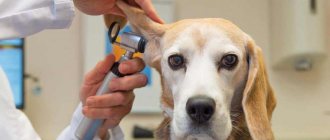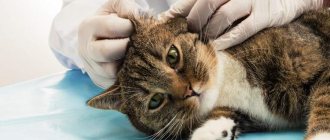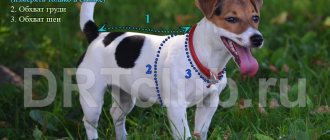Indications
So, the main reason is breed standards.
There are medical indications. These include:
- wounds, burns of the ears;
- tumors, local inflammation, ulcers;
- tissue necrosis;
- other serious damage.
Pets with short ears are less likely to experience bites and injuries. For guard dogs, it's a matter of vulnerability.
Most often, the operation is performed on representatives of the following breeds:
- Caucasian and Central Asian Shepherd Dogs;
- Dobermans;
- Staffordshire Terriers;
- Great Danes;
- Giant Schnauzers;
- pit bull terriers.
Today, many owners prefer not to crop their pets' ears because of the pain of this procedure. Animal rights activists and some dog experts are against it.
Some international exhibitions allow undocked dogs to participate, regardless of breed standards.
Why is it not necessary to crop your ears?
Any attempt to change the shape of the Toy Terrier's ears is considered grounds for disqualifying the dog from the show.
Animals with cropped ears are not allowed to participate in the exhibition..
“I would like to debunk several myths about the benefits of ear cropping in toy terriers. Firstly, the information that dogs with cropped ears do not get otitis media is not true. Quite the contrary, cropped ears cannot protect the ear canal from infections and wind and parasites, and this is precisely what leads to otitis media. Even if your dog's ears do not want to go up, this is not a reason for such a procedure. Secondly, any dog that has undergone docking will experience pain and stress, regardless of age. Thirdly, the entire civilized world has practically moved away from such methods, since this is a useless and meaningless practice. In most European countries, docking is prohibited.”
Optimal timing
The timing of docking a puppy depends on its breed. For small dogs the procedure is carried out earlier than for large breeds. Average age – 2.5 – 3 months. In some cases, cupping can be carried out for up to a year.
Puppies of some breeds are docked at one week of age. For dogs whose entire ear is removed (Caucasian and Central Asian Shepherd Dogs), the procedure is carried out at the age of one to three days.
It is not advisable to trim the ears of adult pets; this is associated with a high risk of complications. Some veterinary clinics provide this service.
How to raise your ears yourself
So, what should you do if your toy’s ears are “in no hurry” to stand up, or the ear that stood up has fallen off again? Starting from 2 months, many owners begin to glue them. To do this, you will need a light and thin tire slightly less than the length of the shell. Make it out of durable plastic or use cotton swabs. You need to glue the tire with a medical plaster that allows air to pass through well, but in no case with electrical tape or adhesive tape.
For each ear, cut out 2 pieces from the patch. It is desirable that they follow the internal shape of the shell from tip to curl, slightly short of the ear hole. We apply a tire to the sticky side of one of the pieces and cover it with the second piece so that its own sticky side remains free. Now the structure can be glued to the inner surface of the sink.
It is advisable to stock up on toys for your toy terrier in advance: when the puppy shakes its ears or paws, or tries to tear off an unknown object, distract it with play. You can offer your baby a treat or hold him in your arms. In a few days he will get used to it.
In some cases (if the sagging was insignificant), the glued ear will finally strengthen after 2 weeks, but on average, experts recommend keeping the glue on the ears for 4–8 weeks. In any case, it is not recommended to remove them until the end of the teeth change. Fallen adhesives are restored if necessary.
If your dog's ears are set too wide apart, this may reduce his score at the show.
Fortunately, such a defect can be easily corrected with a medical patch. Gently grasp the tip of the ear, pull it up and slightly towards the center of the puppy's head. Then carefully twist the shell (clockwise if the ear is on the left, and vice versa), and then wrap several layers of tape just above its base. The winding needs to be adjusted every 2–4 days. Once every two weeks, remove it for a day so that the dog can rest, then restore it until the set of the ears becomes standard.
Similar article: How to quickly accustom a toy terrier to a tray or diaper
It is important that the dog’s nutrition is complete and balanced. Periodically he should eat cottage cheese. Dietary supplements containing calcium and strengthening cartilage can also be purchased at a pet store.
A massage will be useful: placing your thumb on the outside of the ear and your index finger on the inside, gently rub the ear from bottom to top for 5–10 minutes. This increases blood circulation and thereby strengthens the cartilage. Moderate physical activity of the pet itself is also important - a sedentary lifestyle slows down the process of growth of cartilage tissue.
Procedure for the cupping operation
The operation lasts about half an hour, maximum – up to one and a half hours.
The dog is secured with straps on the operating table. They put a muzzle on her. The owner must additionally ensure that the animal does not twitch.
The hair around the ears is cut off and the skin is treated with an antiseptic. Then anesthesia is given. Puppies' ears are trimmed under local anesthesia. For an adult dog, general anesthesia is required.
The procedure is carried out with the following tools:
- surgical scissors;
- clamps;
- pattern for precision cutting.
After trimming, if there is no bleeding, everything went well, the clamps are removed, the edges of the wounds are sutured and treated with an antiseptic. Instead of seams, special glue can be used.
Cupping can be done at home, with a veterinarian visiting. The procedure is similar, but costs more. It is important to choose a professional veterinarian and keep your home clean.
How to prepare your dog for ear cropping?
It is best to perform such an operation on small puppies less than a week old. It is permissible to do this even earlier, immediately after the birth of a small fluffy ball with delicate cartilage or during the first three days of its just beginning life.
This is especially true for breeds whose ears are cut short enough without the need for stitches, for example, Central Asian and Caucasian Shepherd Dogs.
The most painless option, which practically eliminates subsequent complications, discomfort and bleeding, is to dock the ears and tails of tiny creatures directly during childbirth. For breeds with complex ear shapes, surgery is usually performed somewhat later, at up to 45 days of age.
There are also numerous cases of late surgical intervention, but, according to reviews from many dog owners, it is better not to do this. According to the owners, the pain in pets is stronger, the general condition after the operation is much worse, heavy bleeding is possible, as well as more serious complications, which will be discussed below.
The timing of the operation, its possibility and necessity, of course, largely depend on the characteristics of the breed and on the views of the animal owners on this issue.
For example, ear cropping of staff dogs has recently been carried out only at the request of the owner, and specimens of this breed in their original form, gifted by nature, are increasingly appearing in domestic rings.
Surgery is usually performed on these dogs at around 7 weeks of age. It often happens that puppies are still with the breeder at such a time. But if the owner acquires a sufficiently old pet with undocked ears, then the procedure is still possible provided it is carried out in a good clinic under general anesthesia.
Performing the operation on mature dogs is acceptable, but in this case, the cost of ear cropping . The price of the service, it should be noted, directly depends on various factors: the breed of the dog, the age and size of the animal, and also, of course, on the price list of each specific clinic. It can be 2000 rubles or higher.
Owners should also remember that the described procedure is carried out on an empty stomach. And for its successful implementation, it is necessary that the pet refrain from eating food for at least 10 hours.
Special pattern for cropping ears in dogs
Before circumcision, you should carefully monitor your pet’s health for several days, always recording any possible deviations from the norm. If in doubt, you should consult a veterinarian. The pet's ears should be thoroughly cleaned before the procedure.
Rehabilitation period
After the operation, a special collar is put on the dog so that the animal does not damage the stitches.
If your pet is acting restless immediately after surgery, you can give him pain medication (as prescribed by your veterinarian).
The seams are treated with streptocide, hydrogen peroxide or brilliant green. The edge should be periodically soaked with peroxide, carefully removing the scab. It is important to keep the apartment clean to avoid infection.
The stitches are removed after a couple of weeks. If there are complications, healing is not going well or is too slow, you should consult a veterinarian.
After the stitches are removed, the ears begin to be attached. To do this, they are glued or a frame is applied. This process varies for different breeds, so you need to strictly follow the recommendations of your veterinarian or dog handler.
Is it necessary to dock the tail and why?
Standards requiring tail docking for Toy Terriers are a thing of the past. In the modern world, such a dog is not allowed to participate in international exhibitions.
It is for this reason that Russian breeders have stopped docking the tails of toy terrier puppies.
As for Russia itself, here tail docking is allowed and even necessary if you plan to take your pet to exhibitions.
NOTE!
According to standards, the tail of such a dog must be docked (2-3 vertebrae are left).
Another reason why Toy Terriers have their tails docked is because the tip of the tail is broken. The thing is that in this case it is impossible to apply a splint for fusion, since it simply will not hold on.
Here only amputation (cutting) saves . In this case, the operation is performed under general anesthesia, after which a suture is applied. After about 10 days, the suture is removed.
During the wound healing period, it is advisable for the dog to wear a protective collar to prevent licking . If everything is done correctly, recovery occurs quickly.
Possible complications
The following complications are possible during the procedure:
- Heavy bleeding. The older the dog, the higher the likelihood of bleeding.
- Scars, thickening.
- Inflammatory processes.
The risks of any complications depend on age and health status. Another factor is the level of professionalism of the surgeon. A good doctor will eliminate the risks in a timely manner.
If any symptoms appear, you should immediately contact your veterinarian.











